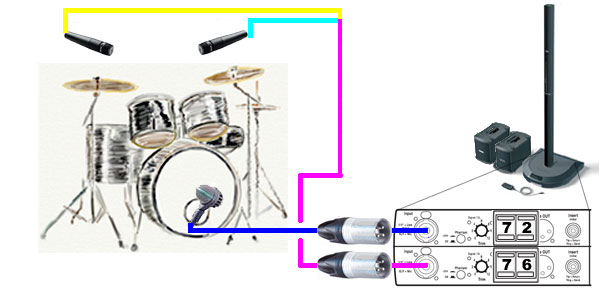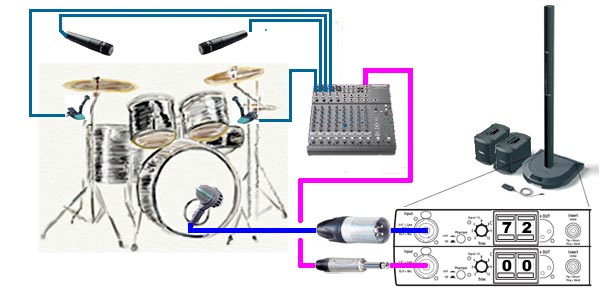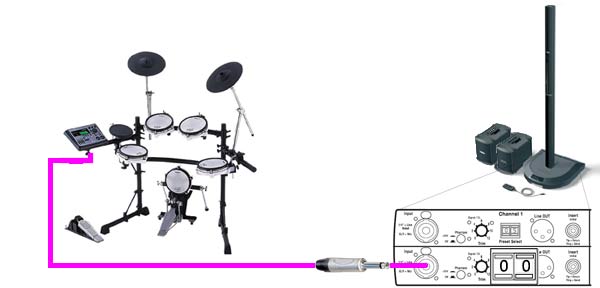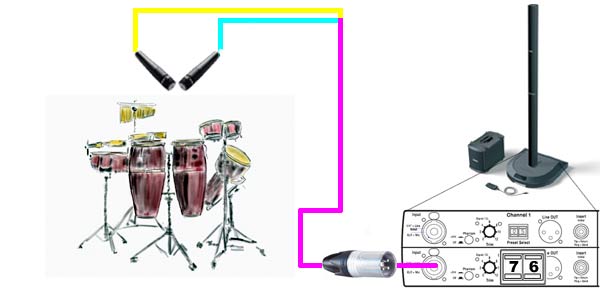Difference between revisions of "Connections / Drums for Model I"
m (details for V-Drums, Presets) |
m (formatting) |
||
| Line 33: | Line 33: | ||
== Out-or-Phase Overheads and Kick Drum == | == Out-or-Phase Overheads and Kick Drum == | ||
| − | This depicts using two Shure SM57 microphones wired [[Instruments/Drums|Out-of-Phase]]. This allows you to have two microphones "overhead" taking only one Channel, leaving another Channel free for the Kick Drum. | + | This depicts using two Shure SM57 microphones wired [[Instruments/Drums#Out-of-Phase Overheads|Out-of-Phase]]. This allows you to have two microphones "overhead" taking only one Channel, leaving another Channel free for the Kick Drum. |
| − | : These are not "overheads" but 57's placed below the cymbals and above the top heads of a small kit. The mics are wired out of phase, basically 2 and 3 reversed on an XLR. There's lots written about this on our forum. But the basic idea is that the pair will cancel onstage bass but pick up local instruments on the kit, in an effort to reduce rebroadcasting onstage bass from the drum mics. This way we get a stronger signal than typical overheads and cleaner bass onstage. To "mix" these, just move the mics closer to the instrument you want to emphasize. Typical setup is on either side of the snare facing the snare. Snare is everywhere and there is no need to put a mic directly on it. It's actually pretty easy to set up and adjust, moving the mics around for a good kit mix. With 3 mics and only 2 inputs on the PS1, we get a really nice amplified sound for our shows. I listened to the output of the pair recently (multitrack recordings of a recent show) and the cancelling thing really works great. Give it a try. -- see [[Instruments/ | + | : These are not "overheads" but 57's placed below the cymbals and above the top heads of a small kit. The mics are wired out of phase, basically 2 and 3 reversed on an XLR. There's lots written about this on our forum. But the basic idea is that the pair will cancel onstage bass but pick up local instruments on the kit, in an effort to reduce rebroadcasting onstage bass from the drum mics. This way we get a stronger signal than typical overheads and cleaner bass onstage. To "mix" these, just move the mics closer to the instrument you want to emphasize. Typical setup is on either side of the snare facing the snare. Snare is everywhere and there is no need to put a mic directly on it. It's actually pretty easy to set up and adjust, moving the mics around for a good kit mix. With 3 mics and only 2 inputs on the PS1, we get a really nice amplified sound for our shows. I listened to the output of the pair recently (multitrack recordings of a recent show) and the cancelling thing really works great. Give it a try. -- see [[Instruments/DrumsOut-of-Phase Overheads|Out-of-Phase]] for complete notes. |
Revision as of 17:54, 30 December 2007
|
Here are several ways to connect your L1 Classic or L1 Model I to
|
Presets
You will want to try the Kick Drum Presets
- 70 Kick Drum
- 71 Kick Drum, Audix D6
- 72 Kick Drum, AKG D112
- 73 Kick Drum, Sennheiser 601
- 74 Kick Drum, Shure Beta 52a
- 75 Generic Overhead
- 76 Drum Overhead, Differential SM57
- 77 Drum Overhead, Differential Electret
- 00 Flat when you are using a mixer
More Bass for the Kick Drum
If you want to add more low end consider getting a PackLite® power amplifier model A1. You definitely want to read B1 Bass Module/Positioning.
Out-or-Phase Overheads and Kick Drum
This depicts using two Shure SM57 microphones wired Out-of-Phase. This allows you to have two microphones "overhead" taking only one Channel, leaving another Channel free for the Kick Drum.
- These are not "overheads" but 57's placed below the cymbals and above the top heads of a small kit. The mics are wired out of phase, basically 2 and 3 reversed on an XLR. There's lots written about this on our forum. But the basic idea is that the pair will cancel onstage bass but pick up local instruments on the kit, in an effort to reduce rebroadcasting onstage bass from the drum mics. This way we get a stronger signal than typical overheads and cleaner bass onstage. To "mix" these, just move the mics closer to the instrument you want to emphasize. Typical setup is on either side of the snare facing the snare. Snare is everywhere and there is no need to put a mic directly on it. It's actually pretty easy to set up and adjust, moving the mics around for a good kit mix. With 3 mics and only 2 inputs on the PS1, we get a really nice amplified sound for our shows. I listened to the output of the pair recently (multitrack recordings of a recent show) and the cancelling thing really works great. Give it a try. -- see Out-of-Phase for complete notes.
Using a Mixer
If you want to have more than two or three microphones for Drums, then you can use a mixer for a submix running to one Channel on your Power Stand. Use another Channel (1 or 2) free for the Kick Drum so you can use a Preset. Although it is not shown here, you could run the mixer to Channels 3 or 4. This would leave you with Channel open for a Vocal microphone.
Electronic (V-Drums)
This is as simple as it gets. Your Drum Module controls all the sound and you take the output to one Channel on your L1™. There is no particular advantage to splitting the out the Kick Drum.
Percussion with Out-of-Phase Overheads
We are using the same approach for Out-of-Phase microphones as we discussed above.





